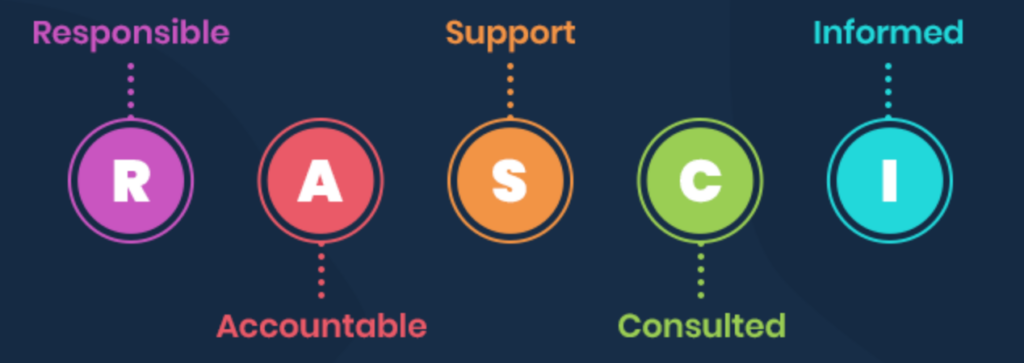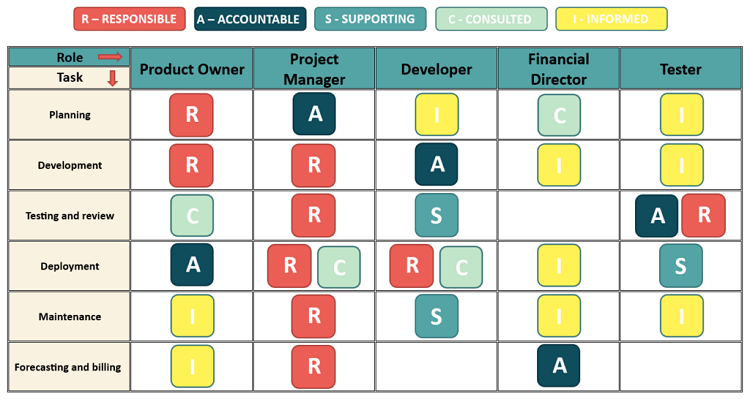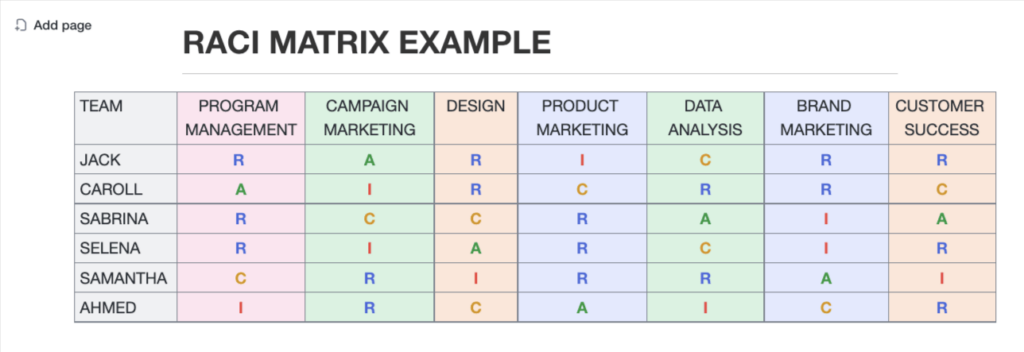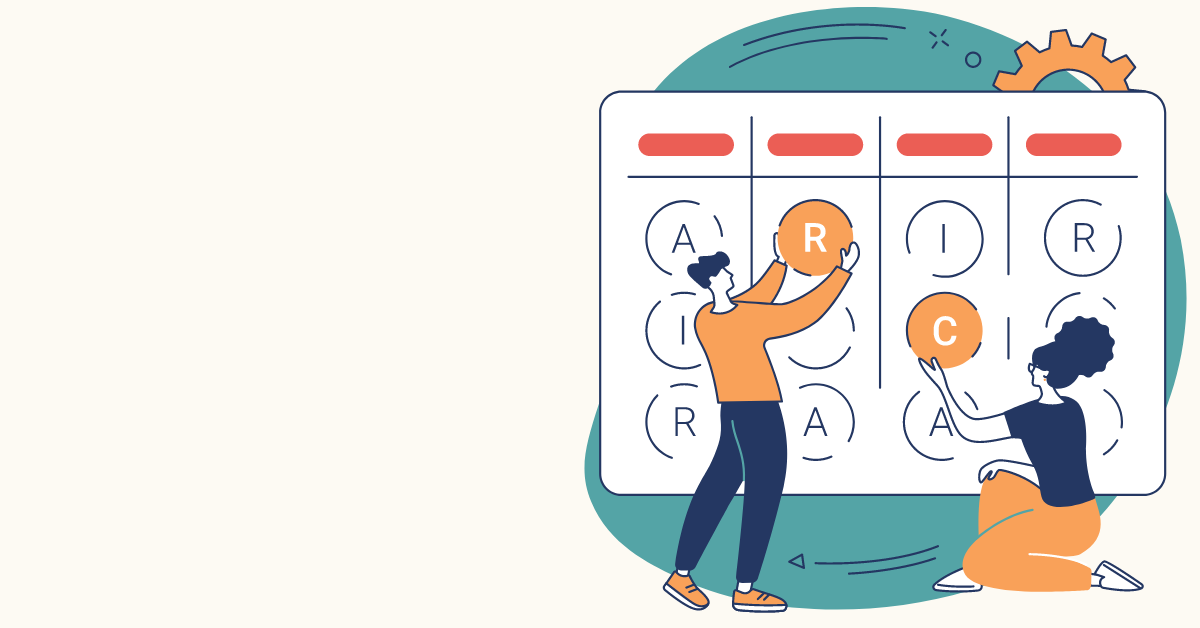RASCI is an excellent way to start a project when requirements and roles are set up first. As a Senior Project Manager, I like to begin a project by confirming the stakeholders, supporting team members, and the functional areas within the scope.
I am a documentation nerd, and it makes record keeping clear and can assist with helping those who are new to project management or the project itself a lot clearer.
One core way to ensure a project’s successful outcome is clearly defining the roles and responsibilities. RASCI fulfills that same function. Let’s consider where, when, how, and why RASCI is used and how to set up a RASCI Matrix.
Bottom Line Up Front
A RASCI matrix or chart sounds much more complex than it is (or needs to be). It defines critical players in a project as those who should be accountable and responsible for executing specified deliverable tasks.
It can help you understand those individuals who should be consulted or informed and those who need to play a supportive role where necessary.
You don’t need advanced knowledge or tools to create your RASCI chart, and it’s an excellent way for junior or senior project professionals to outline the basis for a project and how to assign the key members to tasks.
RASCI Explained
Before we dive into what RASCI is and how to use it, it is essential to understand the basic terminology of RASCI. The structure and roles may also differ depending on the organization’s size.
RASCI Definitions

- Matrix – In reference to RASCI, the word “matrix” can be a synonym for “chart” or “model.” It describes the visual diagram on which the RASCI key points are plotted. “Matrices” describes multiple matrix models.
- Responsible – The “responsible” person is the individual who drives the project and executes the task. In some instances, this may be the product or task owner. The role may be allocated to one or multiple individuals and may have supporting roles.
- Accountable – This person is the person who will be the authority over the project and will manage and assign resources. This is typically one person, and having multiple people fulfill this role is not advised, especially over one project. They would also generally approve the work that the “Responsible” position completes.
- Supportive – As the name suggests, this is a “supporting” role for the other functions. Multiple individuals can fulfill this duty.
- Consulted – The “consulted” role is generally fulfilled by several advisory individuals who are often subject matter experts. In addition, they are consulted for niche advice before the project kicks off.
- Informed – This individual is kept updated throughout the project, and the “Responsible” role executes these updates.
You might also be interested in: Project Management Glossary of Terms: A Comprehensive List of PM Concepts
Who Uses RASCI
You might already be an IT Project manager and think, “Well, I have never used a RASCI. Who even uses this?”
I’ve seen a slight decline in the utilization of RASCI, mainly due to the types of projects I manage that are more flexible (also known as Agile).
That being said, I find that larger, more corporate industries use this where highly structured teams and roles are required to maintain their duties within a silo. It also works well in a project requiring consulting input from subject matter experts or specialist roles.
For example, many projects I work on are within the Investment Banking sector that uses highly specialized software trading platform knowledge. Due to the scarcity of skills in this space, we often need to bring in a consulting role that can advise on the project and stay informed where required.
RASCI is also an excellent tool for those in the Non-IT sector. I see this used frequently in construction, mining, healthcare, and many other industries.
Why It Is Used
Review the pros and cons of using RASCI below, but consider a general project where a clear designation of roles has yet to be done upfront. The negative results are most likely one or a combination of the below:
- Teams are not working together effectively
- Poor communication and understanding of requirements
- Underutilization of particular roles and over-allocation of tasks to specific roles
- Delayed milestones and possibly missed deadlines
- No transparent overview of the project architecture
Implementing RASCI at the start of your project will help avoid many (not all) of the above scenarios or, at the very least, improve some of the negative issues experienced.
How to set up the RASCI Matrix – Step-by-step guide
Horizontal and Vertical Axis
You should have a horizontal axis for roles (team member specific) / The vertical axis can be used for the task or function.
Note: Some prefer using the horizontal axis for the task and the vertical axis for the role, resulting in the same outcome.
Confirm Project Team Members and Stakeholders
Knowing who will be involved at the outset will help you decide what role(s) they should take on. I prefer to understand the skill set of each individual to ensure that I know their capabilities will match the assigned tasks.
Consolidate Requirements and Assign the Deliverables
As a Project Manager, you will understand the client requirements and project plan and have most likely already created some documentation around this.
You should have a list of project deliverables which should be broken down into the type of work/output that needs to be completed.
Once you have this, you can start assigning the tasks to the relevant roles and decide who will be responsible for each item.
Assigning the Roles
- At this stage, you should have only one “Accountable” role for each type of task – it should never be shared between two individuals—the “accountable” has the final say on the outcome.
- By assigning the “Responsible” items to each individual, it becomes clear who will perform the remaining functions – a “Supporting” or “Informed” function.
The “responsible” person is just that – responsible for completing the task - Assign the “Consulted” column next to those needing consultation throughout the project.
- You can now determine to should be the “Informed.” Think of any stakeholders needing to be kept updated about the project delivery.
My Example Below Shows How to Break this Down for a Typical Software Project
Although someone like Financial Director is not involved in the development of a project, they need to be kept informed of project deadlines and changes so that they are aware from a billing perspective.
They can also support or consult with the Project Manager in planning; for example, they might have control of the project budget and resources and, therefore, can assist the Project Manager when budgeting concerns are raised.
Note: These roles will be varied for different project types and organizational structures. The below is just an example.
There may also be gaps where no “I” or “C” role is assigned for a specific task, as they may be unnecessary.

PM TIPS!
Remember, when starting your Matrix, you will consider the most senior roles for those individuals that will be mainly responsible. Therefore, I like to begin by assigning the “Responsible” and “Accountable” roles. It effortlessly defines the starting point, helps you break down the rest of the duties, and considers if any of these will take on additional RASCI roles.
Pros and Cons
Pros
- I’ve seen many junior Project Managers using RASCI (along with other project requirement documents) as it offers a good starting point for those who may not be confident about starting.
- Complementary to the above, the RASCI will help the team understand the stakeholders and their roles in the project.
- A company restructuring or optimization process might need to occur in certain instances. I’ve seen a RASCI work exceptionally well in scenarios where the team resource allocation needs to be evaluated.
- It can assist with a balance of duties to ensure the correct tasks are allocated to the right people, thus avoiding overload or an under-allocation of functions.
- It will assist with coping project authorities and who should be responsible for signing off on the milestones, budgets, and final project outcomes.
Cons
- It is a slightly outdated metric to measure performance. RASCI can also drive the incorrect reinforcement methods, which can be counterproductive in specific teams.
- I am not partial to this structure because it tends to be relatively siloed. For example, it doesn’t allow for Agile and hybrid roles, which is quite likely in smaller projects or those focused on software development.
- Using it as a general management tool in a software environment can be counterproductive when using it alongside sprint and scrum methodology, which requires more of a daily deliverable than an overall project and resource architecture.
- As we can see in the example above, a specific individual (like a Project Manager) could be assigned multiple tasks and can be overloaded if this isn’t managed correctly.
Okay, great, so now you should understand the matrix and how to use it. However, I often get asked, “I’ve heard of RACI but not RASCI, so what is the difference? Which one do I use?”
There is a very slight difference between the two, even though they are much alike. They are both project management tools that assist the Project Manager in defining roles and responsibilities; RASCI, however, carries an additional function that RACI does not.
RASCI defines Responsible, Accountable, Support, Consulted, and Informed roles, as we already know. In addition, the letter “S” in RASCI stands for “Support,” which indicates that stakeholders who offer resources, tools, or other types of support to those responsible for completing a task or deliverable are included.
Let’s refer to RACI as a matrix that defines roles and responsibilities to keep it high-level. In contrast, RASCI includes an additional role for individuals who support those who are responsible.
Deciding when to use RACI and not RASCI will depend on the project size, type, organizational structure, and team. Sometimes, the project may be small, and the supporting role is either not required or already executed by an “R” or “A” person.
PM TIPS
Concerning my last point, don’t get trapped in detail by trying to assign roles to “fill space.” If it’s not needed, do not assign it. Avoid redundancy, as this can lead to confusion and misalignment of duties.
Tools and Training for Implementing RASCI
There are multiple systems out there that comprise features to help you create a RASCI Matrix. These are generally paid-for project management software programs.
My favorite is ClickUp, they have a great variety of templates for Project Managers to use, and their software is user-friendly.
Here’s a simplified view of a RACI template on ClickUp (You can incorporate the “S” role into this)

If you cannot access paid-for software programs, I recommend creating your template on Microsoft Excel to tailor it to your organization’s structure and project deliverables.
If you need additional guidance, have a look at some Youtube tutorials which are free. Alternatively, have a look at the courses listed below.
RACI Matrix Udemy Course
- The basics of creating a RACI matrix are outlined in this course, which is a great starting point if you’re sure where to start.
- However, any course that limits its service offering to only one type of framework can be limiting. Therefore, it’s beneficial to consider classes that show you how to use a methodology or tool within the project context. I would recommend the below course for this reason.
Project Management for Business Analysts (Containing RACI Matrix)
- This course has better reviews and more comprehensive course material covering techniques and tools for running a smooth project.
- Even if you’re not interested in becoming a Business Analyst, you will either use some Business Analysis tasks or work with a Business Analyst in the project space.
- This course contains a section that covers identifying and managing stakeholders, which outlines how to create a RACI matrix and how to use this effectively with some practical examples.
FAQs about RASCI
Answer: I’ve seen RASCI work particularly well with process management tools like Six Sigma, a widely used comprehensive system of techniques and practices to enhance business processes by reducing defects and errors. It can also be used effectively alongside SWOT Analysis, Gantt Charts, and Flow Processes.
Answer: While they can look similar, they are slightly different. For example, the RACI matrix defines roles and responsibilities, while RASCI adds a supplementary role for stakeholders who support those with the primary responsibility.
Answer: No, although I recommend that you do, it is possible to deliver a successful project using other chart types or organizational structures. However, having specifically defined roles and responsibilities is critical.
Conclusion
Although a somewhat dated approach to project management, the pros can easily outweigh the cons, and it gives a simple method to scoping a project in line with a client and internal workflow.
Along with the above, RASCI ideologies can serve in a non-linear approach to project management. It can assist in keeping stakeholders informed and consulted in an overview logic where there may be an oversight of the key department responsibilities involved with the project. This will help create a transparent project which any department can appreciate.
Related read
- Complete Guide to Waterfall Project Management: Its 5 Stages, Pros, Cons, Alternatives & More
- Types of Project Management Frameworks: Top 20 Popular Methods to Consider for Your Business
- Types of Project Management Roles Grouped by Experience & Industry

Tarryn Menzies is a seasoned Senior Project Manager, Agile enthusiast, and the insightful voice behind her expert pieces on Projects Pivot. With a career rooted in hybrid Agile environments, including Scrum, Kanban, and MoSCoW methodologies, her passion for project management is palpable in every article she authors. A certified AgilePM via APMG, Tarryn is well-equipped to delve into the intricacies of project management, leading readers through complex concepts with ease and clarity.
In her current role as an IT Operations & Project Manager, Tarryn consistently achieves a balance of technical proficiency and strategic thinking, making her uniquely suited to interpret the often-intertwined worlds of IT and project management. Her extensive skillset includes Waterfall Project Management, PRINCE2, and Service Delivery, among other things, demonstrating her versatility as a management professional.
Known for her clear communication and problem-solving abilities, Tarryn has a knack for managing stakeholders effectively, steering complex projects towards successful completion. With proficiency in Project Management Software, Jira, and XML, she navigates the digital landscape of project management with ease. Moreover, her familiarity with SaaS and Business Analysis empowers her to engage with the evolving needs of modern project management and she shares all her real-world insights here at Projects Pivot!

